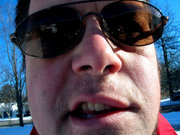Early treatment with antiviral medications and corticosteroids may improve the chances for full recovery from this condition that suddenly paralyzes one side of the face.
Bell's palsy is the sudden partial or complete paralysis of one side of the face. Palsy is the medical term for partial or complete paralysis; Bell's comes from Sir Charles Bell, the 19th-century Scottish physician who first described the anatomy and function of the facial nerve.
Symptoms include a sagging eyebrow, an inability to close one eye completely, and the mouth being drawn toward the unaffected side of the face. Some people have decreased tearing and a loss of taste on the same side of the tongue as the palsy. Another common feature is the ear on the affected side becoming abnormally sensitive to loud noises.
Onset in just a day or two is one of the hallmarks of the condition. If facial paralysis occurs more gradually, it isn't Bell's palsy and suggests other causes of nerve damage, including cancer.
The condition can be very upsetting. It distorts the face, makes it difficult to eat with the mouth closed, and slurs speech. But about 70% of patients have a full recovery within several months and about 15% have minor, residual weakness.
The anatomy
You have a pair of intricately branched facial nerves on the right and left side of your face. (See illustration.) They control the mouth, eyelid, nose, and cheek muscles. Some branches "wire" the tear ducts and the salivary glands. Others carry signals from the tongue back to the brain.
Each facial nerve travels from the brain to your face through a tiny, tortuous passageway in the thick part of your skull just behind your ear. Most cases of Bell's palsy occur when the nerve inside the narrowest part of that passageway becomes inflamed. That starts a vicious cycle of swelling, nerve compression, interruption of the nerve's blood supply, and death of nerve cells. When the nerve can no longer carry incoming and outgoing signals, partial or complete paralysis develops.
Causes
The cause of the initial inflammation has been the big mystery. Now doctors believe that in most cases it's triggered by an infection of the facial nerve by herpes simplex virus, the same virus that causes cold sores. The herpes simplex virus can be in your body for years. No one knows why a dormant infection "wakes up." Experts theorize that the immune system may let down its guard in response to stress or even a minor cold.
Other infectious diseases-including Lyme disease and, rarely, HIV-may cause sudden facial paralysis. Varicella-zoster virus, a related herpes virus and the cause of chickenpox and shingles, is another cause.
Who gets Bell's palsy?
About 40,000 Americans come down with Bell's palsy each year. Teenagers and people in their 20s seem to be most vulnerable, and then incidence levels off until age 60, when it starts to climb again. Pregnancy is a risk factor, especially in the third trimester. People with diabetes are four to five times more likely to get Bell's palsy. Diabetics are also especially vulnerable to a recurrence. About 8% of patients report a family history of Bell's palsy, but it's unclear if the disease has a genetic basis.
Diagnosis and treatment
In most cases, no diagnostic tests are needed. Patients should, though, be tested for Lyme disease if they live where the disease is common.
Injured nerves outside the brain and spinal cord have a remarkable ability to heal, which is why most people will recover from Bell's palsy without any medications.
Even so, it's now standard practice for all patients to get a strong anti-inflammatory corticosteroid like prednisone and an antiviral medication like valacyclovir (Valtrex). Early treatment with corticosteroids improves the chances for a full recovery by about 20%. Combined antiviral-corticosteroid treatment has been shown to work better than the corticosteroid alone.
The window of opportunity closes
Most doctors believe that medications are effective only if the patient starts taking them within two or three days after symptoms first appear. The thinking is that after several days, the damage to the nerve is a fait accompli, so damping inflammation with prednisone won't do much good. And most antiviral medications, regardless of the virus, work best if taken during active infection, before the virus has a chance to proliferate.
A referral to a neurologist, particularly one with some experience with this condition, is generally helpful. Because corticosteroids have wide-ranging metabolic effects that may affect blood sugar levels, many doctors are wary about prescribing them for people with diabetes. But for diabetics who have Bell's palsy, corticosteroids shouldn't be ruled out. Doctors can monitor blood sugar and adjust medications as need be.
Excerpted from the April, 2003 issue of the Harvard Health Letter © 2003, President and Fellows of Harvard College, www.health.harvard.edu.
Copyright American Association of Medical Assistants Jan/Feb 2004
Provided by ProQuest Information and Learning Company. All rights Reserved



